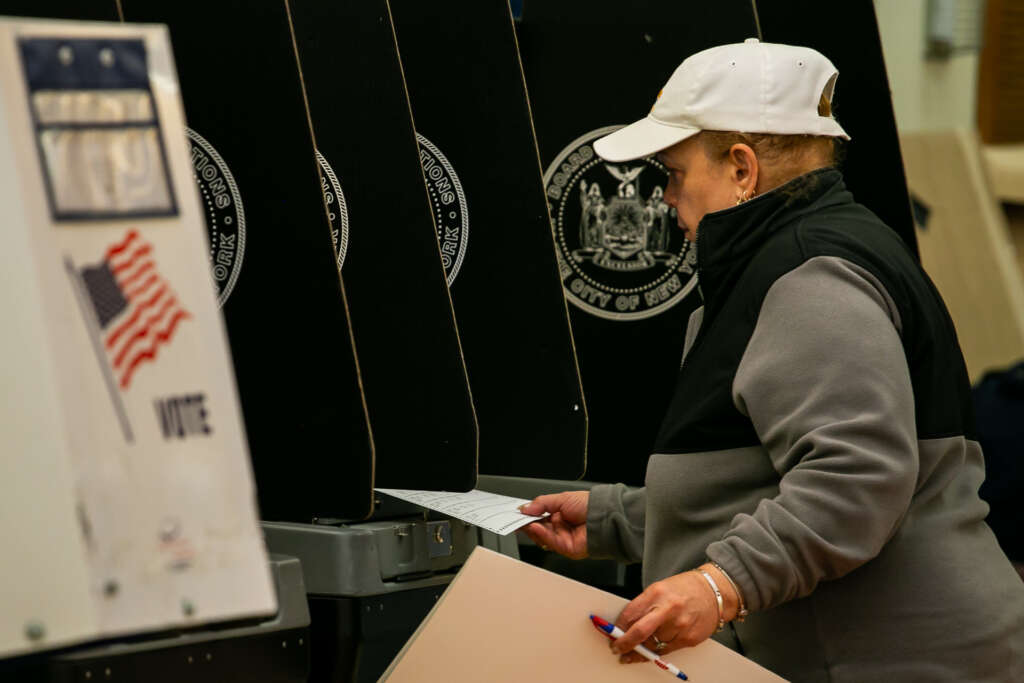“We need even more voices, from every borough and background, to help shape this charter review.”
A Bronx voter casting a ballot in the 2024 elections. Changes proposed by the City Council’s Charter Revision Commission would need to be approved by voters via ballot proposals. (Adi Talwar)
If you believe New York City government can—and should—work better for all of us, I urge you to take part in shaping that future by attending one of the Charter Revision Commission’s upcoming public hearings on May 12, 14, or 19. The City Council’s Charter Revision Commission (CRC), known as the Commission to Strengthen Local Democracy, is holding these hearings to listen directly to New Yorkers about how the City Charter—the document that functions as New York City’s constitution—should evolve.
I’m proud to serve as a member of this commission. When Brooklyn Borough President Antonio Reynoso appointed me earlier this year, I was honored. The most common reaction I’ve gotten is: “Congrats! So… what exactly does a Charter Revision Commission do?” It’s a fair question—one that highlights why this work needs greater public awareness and participation.
The CRC is tasked with reviewing the city’s foundational governing document and proposing updates that ultimately appear as ballot questions for voters to decide. These changes have reshaped our city at critical moments. In 1898, a revision (more accurately, a creation via revision of the state constitution) led to the consolidation of the five boroughs—a move approved by Brooklyn voters by just 267 votes. Some, including myself, have half-jokingly referred to this as the “mistake of ’98,” but it underscores a serious point: charter changes have lasting, wide-reaching impact.
In 1975, a CRC led to the creation of community boards and the Uniform Land Use Review Procedure (ULURP). In 2018, it brought about term limits for community board members. Just last year, voters weighed in on five CRC-generated ballot proposals—four of which passed, most expanding mayoral powers. Yet many New Yorkers don’t even remember voting on them.
At our most recent public hearing—held May 6 at Restoration Plaza in Bed-Stuy—residents showed up with powerful ideas, thoughtful concerns, and a shared commitment to improving how city government works. It was an inspiring evening, but it was just one stop in a broader process. We need even more voices, from every borough and background, to help shape this charter review.
I’d like to see several changes in the charter—ones that would help our city plan more fairly, govern more transparently, and listen more effectively. I’ll highlight two.
First, we need a comprehensive citywide planning process to replace our current piecemeal, project-by-project approach. It’s time we considered the city’s long-term needs and equity at scale, instead of prioritizing isolated interests. The concurrent CRC, led by Executive Director Alex Schierenbeck, is doing excellent work on this front and may ultimately address some of the very issues I’ve raised—an outcome I’d be thrilled to see.
Second, I support Borough President Reynoso’s proposal for an independent Community Board Office that provides CBs with the professional staffing and support they need to effectively represent their neighborhoods and the city as a whole.
At the May 6 hearing, Brooklyn CB4 District Manager Celeste Leon testified on the future of community board reform in ways that align closely with Reynoso. Her remarks reinforced that structural support for CBs isn’t just a bureaucratic upgrade—it’s essential for inclusive and accountable governance.
We also heard from Councilmembers Sandy Nurse, Lincoln Restler, and Chi Ossé, as well as many criminal justice advocates, who offered powerful testimony on how the charter can better support equity, public safety, and accountability. Their contributions emphasized the breadth of issues the CRC is considering and the urgency of ensuring the charter reflects the values of a more just and inclusive city.
Councilmember Ossé spoke about the need to reform the Landmarks Preservation Commission (LPC)—a point I strongly agree with. I elaborated on how our current preservation framework can unintentionally exacerbate the housing crisis, particularly through the unchecked consolidation of housing units in landmarked districts.
My land use staffer, Rebecca Kobert, has been researching this trend: in Community District 6 alone, we’ve lost approximately 1,500 units since 2010 due to consolidation in landmark districts—including 388 units since the start of the COVID-19 pandemic, the most of any district citywide. Reforming LPC to acknowledge and address these outcomes is critical if we want preservation policies that complement, rather than undermine, our housing and equity goals.
Whether you agree or disagree with these ideas, your voice belongs in this conversation. The upcoming hearings on May 12, 14, and 19 are your chance to speak directly to those of us on the Commission.
The charter has shaped New York City for over a century. Let’s ensure it reflects the city we want to build together. As Al Smith said, “All the ills of democracy can be cured by more democracy.”
Mike Racioppo is a commissioner on the Charter Review Commission (The Commission to Strengthen Local Democracy), the district manager of Brooklyn Community Board 6, and a former adjunct professor of political science at Brooklyn College.
The post Opinion: The City Charter Has Shaped NYC for Over a Century—Speak Up! appeared first on City Limits.

